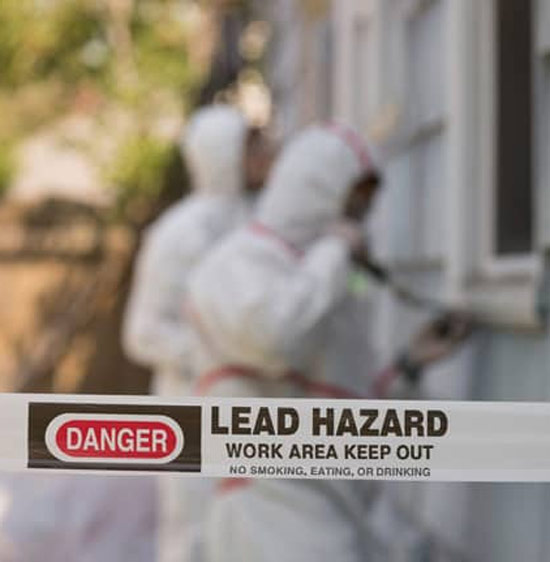Best Practices for Making Sure Safe and Detailed Lead Offense Abatement
Resolving lead offense abatement needs a multi-faceted strategy to guarantee both safety and compliance. First evaluations using innovative detection methods such as XRF analyzers established the phase for an accurate understanding of contamination levels. Integrating appropriate control strategies, consisting of airtight barriers and HEPA filtration, combined with making use of individual safety devices (PPE) for workers, develops the backbone of a protected operation. Meticulous cleaning protocols, featuring HEPA vacuuming and wet-wiping, are essential. It's the last clearance procedure, including extensive inspections and lab testing, that really validates a lead-free atmosphere, making certain long-term security. Just how do these methods interconnect to ensure comprehensive lead abatement?

Preliminary Analysis
Carrying out a preliminary assessment is an important primary step in lead infraction abatement. This stage includes an in-depth examination of the residential or commercial property to identify the visibility, extent, and details places of lead-based dangers. Qualified experts, such as certified lead assessors or take the chance of assessors, ought to carry out a thorough site inspection, making use of devices like X-ray fluorescence (XRF) analyzers to properly spot and measure lead concentrations in paint, dirt, soil, and water.
The analysis has to likewise include a testimonial of the structure's history, previous records, and any kind of problems or wellness issues reported by occupants - Lead Removal Contractors. Documenting the findings carefully is vital, as these documents develop the basis for creating an effective reduction technique. A detailed assessment also involves sampling and laboratory analysis, which are crucial to confirm the visibility of lead and guide subsequent actions
Moreover, it is vital to interact the results transparently to all stakeholders, including homeowner, tenants, and regulatory authorities. By making certain that the preliminary assessment is performed with accuracy and roughness, specialists can lay a strong foundation for a targeted and efficient lead abatement procedure, inevitably safeguarding public wellness and guaranteeing compliance with regulative standards.
Correct Control
Correct containment is vital to stop the spread of lead contaminants during reduction activities. Effectively handling control reduces the danger of lead dirt and debris migrating to non-work locations, therefore guarding both the setting and individuals outside the instant work area. To accomplish proper containment, an airtight obstacle of plastic sheeting have to be developed around the workplace, guaranteeing all seams and edges are safely sealed. Lead Removal Contractors. This barrier needs to extend from flooring to ceiling and be taped to stop any type of leaks.

Regular examinations of the containment location are required to look for violations or weaknesses in the obstacle. Any recognized problems should be quickly resolved to maintain the honesty of the containment. By adhering to these methods, reduction projects can properly control lead contamination and reduce involved health threats.
Worker Protection
Guaranteeing worker protection is critical during lead abatement tasks to avoid occupational exposure to unsafe lead particles. Crucial actions include making use of personal safety devices (PPE) such as respirators, gloves, and full-body fits especially designed to obstruct lead dust and fumes. Employees should undertake extensive training on the proper use and upkeep of PPE, including fit screening for respirators to make certain maximum efficiency.
Engineering controls, such as neighborhood exhaust ventilation systems, are important in reducing air-borne lead concentrations in the work setting. Administrative controls must additionally be applied, including limiting the period of direct exposure and rotating employees to lower individual direct exposure times. Routine clinical monitoring and organic monitoring are vital for early detection of lead absorption, allowing prompt intervention and therapy.
Additionally, establishing a decontamination procedure is crucial. Employees must adhere to strict decontamination treatments prior to breaks and at the end of their change to stop lead dust from being carried outside the job area. This consists of extensive hand and face washing with lead-specific cleaner and altering out of infected garments.
Precise Cleaning
Preserving a secure workplace prolongs past employee security and encompasses thorough cleanup to ensure lead particles are thoroughly removed from the site. The process of thorough cleaning is important in avoiding the recontamination of the moderated location and securing both current and future owners.
To achieve a thorough cleaning, all workspace have to be methodically sanitized. This entails the usage of specialized HEPA (High-Efficiency Particulate Air) vacuum and wet-wiping methods to capture and eliminate fine blog lead dust that might have picked surfaces. It is vital to cleanse all horizontal surface areas, including floors, home window sills, and counter tops, as well as upright surface areas that might have entraped lead fragments.
Workers have to use appropriate personal protective devices (PPE) throughout clean-up to prevent direct exposure to recurring lead dirt. Made use of cleaning materials such as wipes, sponges, and wipe heads ought to be dealt with in conformity with hazardous waste disposal guidelines.

Final Clearance
Final clearance is the crucial concluding phase of lead abatement that figures out whether the site is safe for reoccupation. This critical step involves detailed evaluation and screening to verify that all lead dangers have actually been properly removed.

Final clearance screening not only secures future occupants yet likewise guarantees compliance with local, state, and government guidelines. Furthermore, it acts as a documented recognition of the reduction professional's adherence to market best practices. Making certain a thorough and successful final clearance is important in protecting public health and wellness and cultivating count on the abatement procedure.
Final Thought
Making sure risk-free and complete lead offense reduction demands a complex strategy encompassing preliminary analyses with sophisticated discovery approaches, efficient containment techniques, stringent worker security methods, and thorough useful site cleaning procedures. The last clearance stage, featuring comprehensive examinations and research laboratory testing, is important to confirm conformity with EPA requirements. Adherence to these best practices guarantees a secure setting for owners, minimizes wellness risks, and promotes governing demands, thus promoting public health and safety in lead-affected locations.